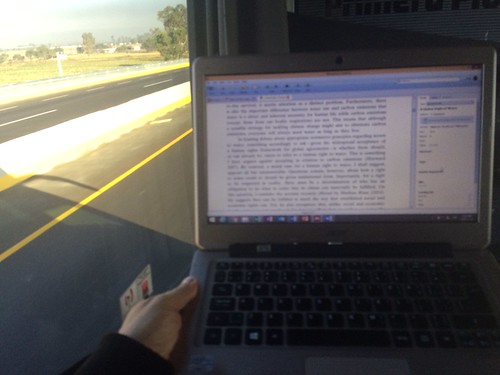 When people visit my campus office, they often admire the fact that I have a systematically organized library where my books and printed articles/book chapters/reports are all available (and ordered alphabetically, in the case of printouts, and by topic, in the case of books). For me, “processing” articles and books/book chapters is a systematic process that enables me to know where to find which piece of research. Thus “processing” entails finding the digital version, saving it, reading it, and then organizing it. I do this to avoid what Pat Thomson calls “PDF alibi”, that is, thinking that I have already processed an article or a book chapter when I simply downloaded it and stored it and I did not read it. Since I integrate reading with my academic writing, I am rarely victim of PDF alibi syndrome. But I have often said, I’m definitely not above doing long stretches of reading, particularly when I am preparing a literature review for a paper.
When people visit my campus office, they often admire the fact that I have a systematically organized library where my books and printed articles/book chapters/reports are all available (and ordered alphabetically, in the case of printouts, and by topic, in the case of books). For me, “processing” articles and books/book chapters is a systematic process that enables me to know where to find which piece of research. Thus “processing” entails finding the digital version, saving it, reading it, and then organizing it. I do this to avoid what Pat Thomson calls “PDF alibi”, that is, thinking that I have already processed an article or a book chapter when I simply downloaded it and stored it and I did not read it. Since I integrate reading with my academic writing, I am rarely victim of PDF alibi syndrome. But I have often said, I’m definitely not above doing long stretches of reading, particularly when I am preparing a literature review for a paper.
I don't know what you're doing with your life right now, but I am organizing journal articles pic.twitter.com/jAMpwqpHLM
— Dr Raul Pacheco-Vega (@raulpacheco) November 29, 2016
For me, processing a paper (or a piece of work) entails the following stages: First, I give it a very quick read. Then, I decide if this piece requires deeper engagement with it, be it through highlighting and scribbling on the margins, be it by writing a rhetorical precis, or be it by preparing a detailed memorandum.
I file each printed piece into magazine holders which I also label by topic/paper I am writing. I do same digitally pic.twitter.com/aBcK0s9Mba
— Dr Raul Pacheco-Vega (@raulpacheco) November 29, 2016
Often times, the bunch of printed output that I need to process comes from a detailed citation tracing search. I am currently writing a literature review on the human right to water, so I had to catch up on everything that has been published since I last did one (e.g. in the last four months).
Paper Processing Protocol 1: I undertake a thorough citation tracing search https://t.co/hihmBsjlFZ to find relevant articles #PhDChat
— Dr Raul Pacheco-Vega (@raulpacheco) November 29, 2016
The process is as I’ve shown above: I download the PDF using Last Name, Year and Title of the document. I organize each file in a folder (I do have a folder for PDFs “To Be Organized”). I also print it out and sort it as indicated above (and in this post). I also upload the PDF on to my Mendeley database and clean up the reference.
When the paper is relevant but I don’t think I have the time to prepare a detailed memorandum, I simply write a rhetorical precis that I can then type and digitize and add into my Evernote library. This makes my database of rhetorical precis searchable and findable. I also save the file into my Dropbox in the folder for the paper I am currently writing.
When I have a good number of articles that are worth memo-ing, I dump the memorandum (or at least, the most relevant quotations) into my Excel conceptual synthesis worksheet. Even if I only write a rhetorical precis, I always keep it also in the literature review Excel worksheet, so that I know which articles to refer back to.
When I write the rhetorical précis, I highlight and scribble notes, and then I decide this paper is worth memo-Ing pic.twitter.com/fu1X4JdESW
— Dr Raul Pacheco-Vega (@raulpacheco) November 29, 2016
If the paper is worth writing a memo on, make sure it's effective https://t.co/hACSfydHPC if not worth memo, then rhetorical precis.
— Dr Raul Pacheco-Vega (@raulpacheco) November 29, 2016
Often times, I’ll scribble notes in my Everything Notebook that are related to a specific piece of printed work. When that happens, I use the last name of the author and the year to prepare a plastic tab and use that tab to separate my scribbles on the Everything Notebook (and to ensure that I can find my notes easily!)
Again, the point of this post is: NEVER FILE A PAPER UNTIL YOU’VE READ IT.
@LRussellWolpe @raulpacheco Yes, advice from one of my mentors was never file a paper until it is read!
— Ian McPhee (@iGas2) November 29, 2016
In my case, I never file something until I’ve processed it. Hopefully my method is useful to you!


I’ve come back to this blog post throughout the years of my PhD journey. Thanks so much for going into great detail regarding what works for you. I’ve taken your method as a template and tweaked it to make it my own!